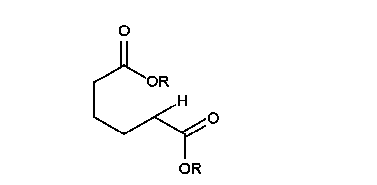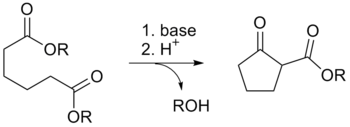Dieckmann condensation
Source: Wikipedia, the free encyclopedia.
Chemical reaction of diesters
| Dieckmann condensation | |
|---|---|
| Named after | Walter Dieckmann |
| Reaction type | Ring forming reaction |
| Identifiers | |
| Organic Chemistry Portal | dieckmann-condensation |
| RSC ontology ID | RXNO:0000065 |
The Dieckmann condensation is the
intermolecular reaction is the Claisen condensation. Dieckmann condensations are highly effective routes to 5-, 6-, and 7-member rings, but poor for larger rings.[4]
Reaction mechanism
Deprotonation of an ester at the α-position generates an
Brønsted-Lowry acid (H3O+ for example) re-forms the β-keto ester.[5]
Due to the steric stability of five- and six-membered rings, these structures will preferentially be formed. 1,6 diesters will form five-membered cyclic β-keto esters, while 1,7 diesters will form six-membered β-keto esters.[6]

|
| Animation of the reaction mechanism |
Further reading
- Dieckmann, W. Ber. 1894, 27, 102 & 965
- Dieckmann, W. Ber. 1900, 33, 595 & 2670
- Dieckmann, W. Ann. 1901, 317, 51 & 93
See also
References
- ^ Davis, B. R.; Garrett, P. J. Compr. Org. Synth. 1991, 2, 806-829. (Review)
- ISBN 9780470771099.
- ISBN 0471264180.
- ISBN 978-0-471-72091-1
- ISBN 978-0073327495.
- ^ "Dieckmann Condensation". Organic Chemistry Portal.


